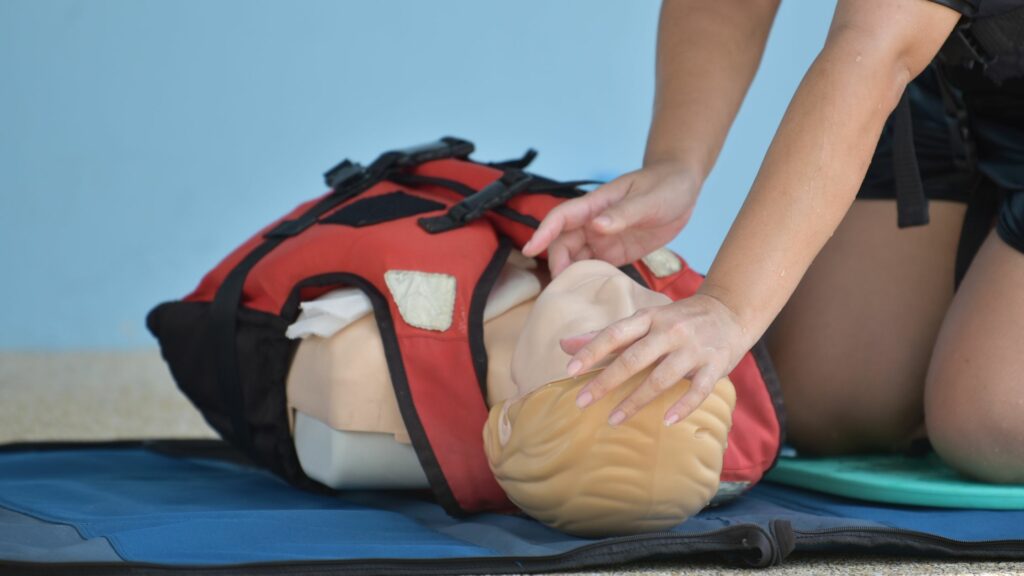Emergencies do happen! It’s important to know what lifesaving techniques to apply based on the health problem. Is basic life support appropriate? What about CPR? Are these the same thing?
CPR is an essential skill that can help save lives at home, work, or other public places. Despite being different from CPR, BLS and CPR are terms that are often used interchangeably. Keeping the person’s airwåay open and boosting blood circulation without mechanical assistance are two common rescue techniques included in both BLS and CPR training. The primary distinction between BLS and CPR is that BLS incorporates lifesaving methods required in a hospital or medical environment.

What Is Basic Life Support (BLS)?
Basic life support (BLS) is a higher degree of medical care that is often provided by paramedics, first responders, healthcare professionals, and trained bystanders. It includes CPR. Until patients receive more sophisticated medical care at a hospital, BLS assists someone in cardiac arrest or respiratory distress with lifesaving care.
BLS involves the following:
- Airway maintenance
- An initial assessment
- CPR
BLS is designed for medical professionals or persons with prior medical experience because the average person needs more medical understanding to evaluate the patient’s condition or perform airway maintenance.
What Is CPR?
CPR is an immediate lifesaving technique used on patients whose hearts have stopped beating.
Although mouth-to-mouth resuscitation procedures have been used for decades, modern CPR was first created in 1960.
CPR entails breathing air into the victim’s mouth to keep oxygen circulating throughout the body while performing chest compressions to keep the heart beating until assistance arrives. Additionally, giving CPR improves the likelihood that the victim’s heart will react to defibrillation, another lifesaving procedure.
Anyone can get their CPR certification, and it might even be mandatory based on your profession.
Is BLS the Same as CPR?
BLS certification training covers CPR; however, since the certification is geared toward healthcare professionals, the course is more in-depth than standard CPR courses. A typical BLS course will cover team and single-rescuer basic life support techniques, emergency scenario precautions, safety measures, and legal issues to be aware of when providing lifesaving care. Furthermore, you could study how to treat burns and wounds and cope with poisoning and fractures.
Since a CPR certification is typically sufficient to deliver lifesaving care in schools, offices, or other safe environments, not everyone needs to obtain a BLS certification.
Here’s an in-depth breakdown of the differences:
The Attendees
A variety of individuals enroll in these courses and pursue credentials. Many participants in BLS training are either working as professional rescuers or enrolled in school to become medical professionals such as nurses, doctors, or EMTs. They frequently have access to specialized lifesaving tools that are not generally available to the general population because their job responsibilities require more organized and precise care.
People from many walks of life will enroll in CPR classes, including personal trainers, business managers, and babysitters. These people often only need to be familiar with CPR and how to contact the appropriate authorities because their jobs are comparatively low-risk.
The Curriculum
The target audience of BLS and CPR training is one of the key distinctions between them. They use different methods to deliver lifesaving treatment, enabling people from various occupations to acquire the precise training they want.
While CPR training teaches you the fundamentals of conducting the CPR technique on a coworker or family member as a single rescuer, basic life support courses are often more in-depth and sophisticated and are based on working together with other trained rescuers in the medical industry.
The Applications
The course participants influence how the instructors present and organize the material. Additionally, how BLS or CPR skills are used differs from person to person. A professional rescuer who responds to emergency calls will use BLS techniques on a daily basis.
If there is an emergency, a business professional will use CPR at work or home. While other businesses encourage CPR training, employers in the healthcare field demand a BLS certification from the American Heart Association.
Choosing the appropriate class for you will be aided by your knowledge of the distinctions between a BLS and CPR certification.
Which Certification Do I Need?
This depends on the motivation behind your qualification. A traditional CPR certification is a terrific option if you want to feel better prepared in an emergency. If you need more clarification, you can always ask your employer. Those working in education, coaching, or childcare generally only need a CPR certification.
A BLS certification is ideal if you work in the healthcare industry, including dentistry. It will equip you with the abilities necessary to render lifesaving care outside a hospital setting.
BLS and CPR Recertifications
It is imperative to maintain your understanding of BLS and CPR, especially if you’re not practicing them on a daily basis. Because of this, the American Red Cross mandates that recertification courses be completed regularly.
The validity of BLS and CPR certificates is two years and one year, respectively. Online courses for CPR, BLS, and First Aid recertification are all accessible. In fact, as an added convenience, the majority of e-learning programs will send you reminders to let you know when you have to renew your certification.
Do You Need BLS or CPR Training? Contact ROI Safety Services Today!
BLS involves a more thorough training program that includes CPR and goes beyond it, which is the main distinction between it and CPR. While BLS is more appropriate and often necessary for people who work in the healthcare area particularly, CPR is advised for anyone whose lifesaving skills could be useful in their line of work.
Whatever the case, learning these abilities can save lives, and everyone can use them to their advantage in an emergency. Therefore, we urge you to learn more about these treatments because you never know—you might save someone’s life one day.
If you’re interested in getting a BLS or CPR certification, please visit our website or contact us at 714.520.1608 for further information.

